The biggest supermoon of 2019 will appear in the night sky on February 19. At 10:53 a.m. ET, it will be only 221,681 miles away from Earth—and because of this close approach it will appear bigger and brighter than any other full moon of the year.
A supermoon is a term referring to the coincidence of two celestial events—a full moon, and the lunar perigee, otherwise known as its closest approach to Earth. As the Moon orbits Earth, the distance between the two objects changes. Its furthest point, known as the apogee, is around 238,000 miles. When this coincides with a full moon, it is known as a micromoon.
February's full moon will be the biggest supermoon of the year, coming closer to Earth than at any other point in 2019.
"Some astronomers dismiss 'supermoons' as media hype, but to me, anything that encourages people to gaze up is a great way to re-engage people with the night sky," astronomer Paul Cox said in a statement. "I defy anyone who witnesses a supermoon rising at dusk not to be awestruck by the experience."
Cox, who is affiliated with the Slooh robotic telescope based at the Institute of Astrophysics of the Canary Islands, will be part of a panel hosting a live show on the February supermoon. You can watch a livestream of the event, which starts at 7 p.m. ET on February 19, below.
Slooh notes that during the supermoon, perigean spring tides are generated. These are "higher than normal tides" and result from the increased gravitational pull of the moon on the oceans.
The National Oceanic and Atmospheric Administration notes that perigean spring tides only lead to a very small increase—normally just a couple of inches. "The largest difference occurs in certain areas of the Alaska coast where the range of the tide was increased by approximately 6 inches," it said. "But considering that these areas have an average tidal range of more than 30 feet, the increase is but a small percentage of the whole (less than a 2 percent increase)."
This month's full moon is also known as a "snow moon." According to the Farmer's Almanac, native tribes gave it this name because it was the month that had the heaviest snowfall.
February's full moon is the middle of three supermoons in a row. January's coincided with a total lunar eclipse—an event where the moon passes directly through Earth's shadow. When this happens, light from the sun refracts around Earth, making the moon appear red.
The next supermoon will take place on March 21, only four hours after the March equinox—when day and night are the same length, with days in the northern Hemisphere getting longer thereafter.

Visit Slooh.com to snap and share your own photos from this live event, interact with the hosts and guests and personally control Slooh's telescopes.
Uncommon Knowledge
Newsweek is committed to challenging conventional wisdom and finding connections in the search for common ground.
Newsweek is committed to challenging conventional wisdom and finding connections in the search for common ground.
About the writer
Hannah Osborne is Nesweek's Science Editor, based in London, UK. Hannah joined Newsweek in 2017 from IBTimes UK. She is ... Read more
To read how Newsweek uses AI as a newsroom tool, Click here.








